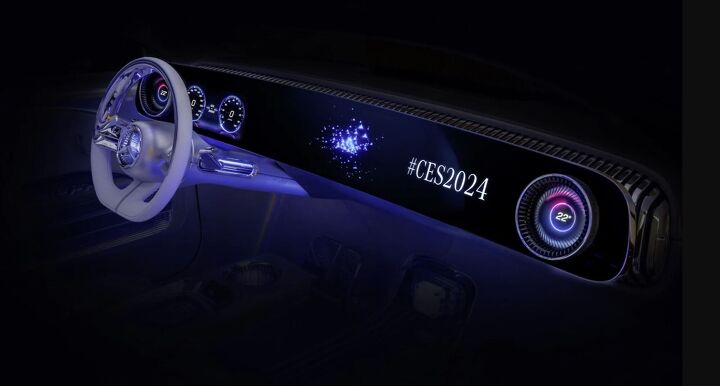
Mercedes-Benz is teasing the next generation of its user experience ahead of the official reveal it has scheduled for CES 2024. The proprietary Mercedes-Benz User Experience (MBUX) is said to boast a voice assistant that uses artificial intelligence and more space for screens than ever before.
Details are limited before the official premiere. But the company has promised a new visual interface, developed with game-engine graphics from Unity, that is supposed to help drivers communicate with the new voice assistant. It’s also going to feature a “selfie camera” installed in the cabin.
Framed as a way to take candid pictures of vehicle occupants by the manufacturer, the device has actually been mandated by the European Commission for all new vehicles by 2026 as a way to “combat distracted driving.” The United States has a similar program under the so-called Bipartisan Infrastructure Law running on an identical timeline. Though it’s operating under the auspices of combating drunk driving and doesn’t have a firm regulatory framework in place.
While in-cabin cameras have started to appear on vehicles featuring “hands-free” driving aids to allegedly guarantee operator attentiveness, Mercedes seems to be the first automaker planning to put them into an entire vehicle lineup. Future implementation may hinge on how these camera systems are received by the public. Some drivers seem fine with having cameras, controlled by a multinational corporation, installed into the dashboard. But others, myself included, are ready to go to war over automotive privacy and what constitutes true vehicle ownership — as none of this seems emblematic of a healthy society.
The entire, button-free design being previewed runs the risk of not resonating with Western audiences, frankly. Driver satisfaction surveys from the U.S. have certainly been trending down in recent years. While some of that pertains to lapses in overall reliability occurring in recent years, changing infotainment systems look to be the largest contributing factor. People are finding the technologies equipped to modern cars more invasive and difficult to use than hoped.
While touchscreens do create new ways of interfacing with the vehicle and allot for additional user customization, they have also encouraged brands to swiftly move away from traditional vehicle controls. This is despite overwhelming evidence that buttons and knobs are easier to use, safer to operate while a vehicle is in motion, and often end up being preferred by drivers.
Though it could be argued that the biggest issue could be how quickly the new interface will make Mercedes’ future products look dated. One of the reasons people appreciate German brands is due to the fact that their vehicles tend to age with some amount of grace. For decades, companies like Mercedes-Benz and BMW were stressing the fundamentals while deftly implementing the latest technologies.
By contrast, the Mercedes-Benz of today seems to believe that technology and luxury are wholly synonymous. An automobile cannot be considered truly luxurious or premium by the brand if it’s not beating you over the head with the latest infotainment gimmicks.
“Mercedes-Benz is reinventing the digital passenger experience by leveraging AI to offer human-like interaction with the intelligent MBUX Virtual Assistant,” stated Ola Kallenius, CEO of Mercedes-Benz. “It includes empathetic characteristics that sync with your driving style and mood. Paired with our in-house MB.OS architecture, this approach will define the future of digital luxury.”
Considering that the brand’s average customer in America is roughly 55 and likely to be growing tired of having to manage their vehicle through another phone app, it seems like Mercedes is shooting itself in the foot here. But then we would be forgetting the importance of China.
All of the above is emblematic of what the Chinese market considered luxury. The region gravitates toward spacious cabins boasting high levels of visual opulence and doesn’t seem to care one whit about performance. They want plush upholstery with ornate stitching, chrome accenting, widespread automation, and the promise of something being high tech.
A lot of the automotive trends Chinese luxury brands are running with today were copied from high-end German products of the past. But one item that seems to have come full circle is massive screens that encompass the entire dashboard. You can hardly find a high-end Chinese automobile produced today without them. This is important because China has become Mercedes’ largest market by a wide margin. European volumes likewise dwarf North American sales, further encouraging the brand to make decisions that might not be as popular here.
Embedding vehicle controls through touch screens is also often cheaper than having to source and install a series of physical controls stemming from numerous suppliers. But this likely wasn’t the case for the updated MBUX system. While it will undoubtedly create new revenue opportunities for the brand via connected services and subscription fees, the development costs to produce the updated version of Mercedes visual interface still had to be significant.
Credit should be given where credit is due. It is not as if the company simply threw in a 12-inch screen, added a silver bezel, and called it a day. The display takes up the entire width of the vehicle and comes with graphics that are supposed to adapt to your mood based on how the car perceives your present emotional state. Benz has everything riding on the new MBUX system being a winner and wants it to dazzle people so they don’t question some of its more insidious aspects or why it the company keeps downsizing engines.
We’ll gain a better understanding of the interface when CES (formerly the Consumer Electronics Show) kicks off in Las Vegas next month. But it looks like Mercedes continues betting big on connectivity technologies and bold cabin designs it believes won’t alienate drivers or make the interior look horribly dated in a few years.
[Images: Mercedes-Benz]
Become a TTAC insider. Get the latest news, features, TTAC takes, and everything else that gets to the truth about cars first by subscribing to our newsletter.

